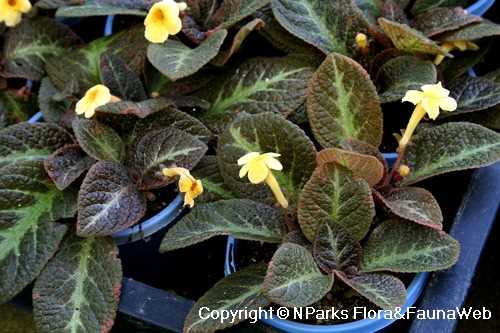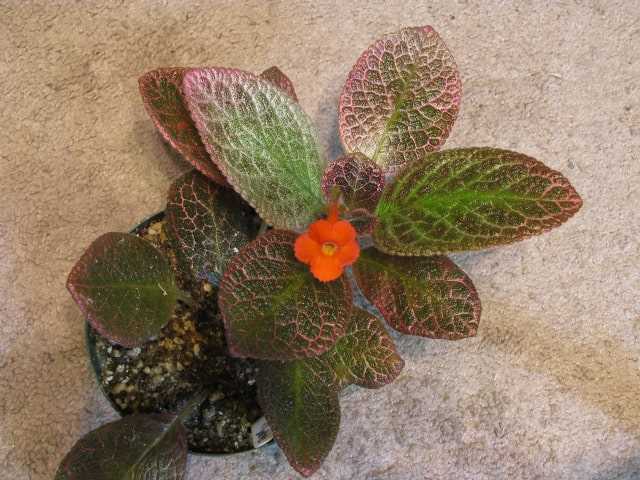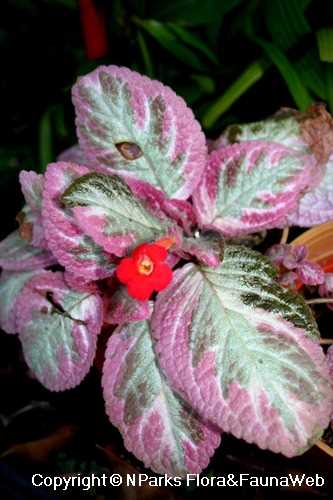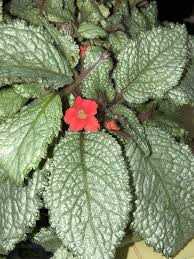- How to Care for Episcia
- Light:
- Water:
- Temperature and Humidity:
- Soil and Fertilizer:
- Pruning and Propagation:
- Pests and Diseases:
- Conclusion
- Episcia Species: A Comprehensive Overview
- Episcia cupreata
- Episcia reptans
- Episcia dianthiflora
- Other Episcia Species
- Cultivation and Care
- Conclusion
- Benefits of Growing Episcia in Your Home
- 1. Gorgeous Foliage
- 2. Easy Care
- 3. Air Purification
- 4. Low-Maintenance Propagation
- 5. Versatile Plant
- 6. Therapeutic Benefits
- Tips for Propagating Episcia
- 1. Leaf Cuttings
- 2. Rhizome Division
- 3. Lateral Shoots
- 4. Water Propagation
- 5. Air Layering
- Common Pests and Diseases of Episcia
- Pests
- Diseases
- Beautiful Episcia Varieties: A Photo Gallery
- Q&A:
- What is Episcia?
- How do I care for Episcia plants?
- What are some popular Episcia species?
- Can Episcia plants be grown indoors?
- Do Episcia plants require any special care in the winter?
- How do I propagate Episcia plants?
- Video: How to Grow & Cultivate Episcia / Flame Violet : Episcia Plant Care

Episcia is a genus of flowering plants in the family Gesneriaceae. It includes over 20 species native to tropical regions of Central and South America. The plants are known for their colorful and patterned leaves, as well as their small, tubular flowers that bloom in various shades of red, orange, yellow, and pink.
Episcia plants are relatively easy to care for and are popular as houseplants. They prefer bright, indirect light and should be kept in a warm and humid environment. It’s important to water them regularly, but ensure that the soil is well-drained to prevent root rot.
There are several popular species of Episcia, including Episcia cupreata, Episcia dianthiflora, and Episcia reptans. Each species has its own unique characteristics and care requirements. Episcia cupreata, also known as the flame violet, is known for its stunning copper-colored leaves. Episcia dianthiflora, or the candy flower, has pink flowers and variegated leaves. Episcia reptans, or the creeping episcia, has trailing stems and small, white flowers.
In this ultimate guide, we will explore the care tips for Episcia plants, look at stunning photos of different species, and provide information on how to identify and propagate Episcia plants. Whether you’re a beginner or an experienced plant enthusiast, this guide is your go-to resource for all things Episcia!
How to Care for Episcia
Episcia plants are known for their beautiful foliage and vibrant colors. Here are some key factors to consider when caring for your Episcia:
Light:
Episcias prefer bright, indirect light. They can tolerate some morning or evening sun, but direct sunlight can scorch their leaves. Place your Episcia in a location with bright, filtered light, such as near a north or east-facing window. Artificial grow lights can also be used to provide the necessary light intensity.
Water:
Episcias like to be kept slightly moist, but not waterlogged. Water your plant when the top inch of soil feels dry to the touch. Avoid allowing the plant to sit in standing water, as this can lead to root rot. Episcias are sensitive to chlorine and other chemicals present in tap water, so it’s best to use filtered or distilled water if possible.
Temperature and Humidity:
Episcias thrive in temperatures between 65-75°F (18-24°C). They do best in environments with high humidity, around 50-60%. If your home is dry, you can increase humidity by using a humidifier, placing the plant on a pebble tray filled with water, or misting the leaves regularly. Avoid placing Episcias near drafts or heaters, as they prefer stable temperatures.
Soil and Fertilizer:


Use a well-draining potting mix that retains some moisture but doesn’t get waterlogged. A mixture of peat moss, perlite, and organic matter like compost or leaf mold works well. Fertilize your Episcia every 2-4 weeks during the growing season with a balanced, water-soluble fertilizer diluted to half strength. Avoid overfertilizing, as this can lead to salt buildup and damage the plant.
Pruning and Propagation:
To keep your Episcia compact and bushy, pinch back the stems regularly. This will encourage branching and prevent legginess. Episcias can be easily propagated from stem cuttings. Simply cut a healthy stem below the node and place it in moist soil or water until roots develop.
Pests and Diseases:
Common pests that can affect Episcias include aphids, spider mites, and mealybugs. Keep an eye out for any signs of infestation, such as discolored leaves or webbing, and treat the plant accordingly. Episcias can also be susceptible to root rot if overwatered or exposed to excessive moisture. Ensure proper drainage and avoid overwatering to prevent this.
Conclusion
By providing the right conditions and care, your Episcia plant will reward you with its stunning foliage and colorful blooms. Remember to adjust watering and light levels as needed and regularly inspect your plant for any signs of pests or diseases. With proper care, your Episcia will thrive and bring beauty to your home or garden.
Episcia Species: A Comprehensive Overview
Episcia, also known as flame violets or chocolate soldier, is a genus of flowering plants in the family Gesneriaceae. There are around 15 recognized species in the Episcia genus, each with its unique features and characteristics.
Episcia cupreata


Episcia cupreata, commonly known as chocolate soldier, is one of the most popular species in the Episcia genus. It has heart-shaped leaves with distinctive copper-colored patterns, hence the name. The flowers of Episcia cupreata are small, tubular, and usually violet or pink in color.
Episcia reptans
Episcia reptans, also called trailing flame violet, is another well-known species. It has long, trailing stems that make it an excellent choice for hanging baskets. The leaves of Episcia reptans are elliptical and have maroon-colored veins against a green background. The flowers are small, funnel-shaped, and can be white, pink, or purple.
Episcia dianthiflora
Episcia dianthiflora, commonly known as fringed flame violet, is a beautiful species with deeply cut leaves that resemble dianthus flowers. The leaves are dark green with reddish-purple veins. The flowers of Episcia dianthiflora are white or pale pink and have fringed petals, adding to their charm.
Other Episcia Species
Aside from the aforementioned species, there are several other Episcia species worth noting, including Episcia lilacina, Episcia sylvatica, Episcia xiphioides, Episcia fendleri, and more. Each of these species has its own distinct leaf shape, color patterns, and flower characteristics.
Cultivation and Care
Episcia species are generally easy to care for, making them popular choices for indoor gardening. They prefer bright, indirect light and well-draining soil. The temperature should be kept between 60-75°F (15-24°C) for optimal growth. Episcia species are moderate water consumers and should be watered when the top inch of soil feels dry. Overwatering should be avoided to prevent root rot. Regular feeding with a balanced fertilizer is recommended to support healthy growth.
Conclusion
Episcia species are stunning plants that add a splash of color to any indoor space. With their unique leaf patterns and charming flowers, they are sure to captivate any plant enthusiast. Whether you choose Episcia cupreata, Episcia reptans, or any other species, following proper care guidelines will ensure their successful cultivation and a happy addition to your plant collection.
Benefits of Growing Episcia in Your Home
Episcia is a type of houseplant that offers several benefits when grown in your home. Whether you are an experienced plant lover or just starting to explore indoor gardening, here are some advantages of having Episcia in your collection:
1. Gorgeous Foliage
One of the main attractions of Episcia is its stunning foliage. With beautiful patterns, colors, and textures, these plants can add a pop of color and visual interest to any space. From vibrant reds and oranges to deep greens and purples, Episcia leaves come in a variety of shades that can enhance the overall aesthetic of your home.
2. Easy Care
Episcia is known for being relatively easy to care for, making it a great choice for beginners or busy individuals. These plants prefer bright, indirect light and well-draining soil. They also enjoy regular watering, but it’s important not to overwater. As long as you provide them with the right conditions, Episcia can thrive with minimal effort.
3. Air Purification
Like many houseplants, Episcia can help improve the air quality in your home. They absorb carbon dioxide and release oxygen during the day, helping to freshen the air and create a healthier living environment. Episcia can also remove certain toxins and pollutants from the air, improving overall air quality.
4. Low-Maintenance Propagation
If you enjoy propagating plants, Episcia is a great option. They can be easily propagated through stem cuttings or by dividing their roots. This allows you to expand your Episcia collection or share plants with friends and family without much hassle.
5. Versatile Plant
Episcia is a versatile plant that can be grown in various ways. Whether you prefer hanging plants, trailing vines, or compact pots, Episcia can adapt to different growing conditions. Their versatility makes them suitable for various spaces, from small apartments to spacious homes.
6. Therapeutic Benefits
Gardening and taking care of plants have been proven to have therapeutic benefits. Spending time with Episcia, tending to their needs, and watching them grow can reduce stress, improve mood, and create a sense of calmness. Having Episcia in your home can contribute to your overall well-being and provide a relaxing environment.
In conclusion, growing Episcia in your home can bring several benefits, ranging from aesthetic appeal and ease of care to air purification and therapeutic benefits. Consider adding these beautiful plants to your indoor collection and enjoy their many advantages.
Tips for Propagating Episcia
1. Leaf Cuttings


One of the most common methods of propagating Episcia is through leaf cuttings. Here’s how to do it:
- Select a healthy leaf from the parent plant.
- Cut the leaf near the base, making sure to include a small section of the stem.
- Place the leaf cutting in water or a well-draining potting mix, with the cut end inserted into the substrate.
- Keep the cutting in a warm and humid environment, but avoid direct sunlight.
- After a few weeks, roots and new plants should start to develop. Once the new plants are well-established, they can be potted up individually.
2. Rhizome Division


Rhizome division is another effective method of propagating Episcia. Follow these steps:
- Carefully remove the parent plant from its pot.
- Gently separate the rhizomes, making sure each division has at least one healthy shoot and a few roots.
- Place the divisions in separate pots with fresh potting mix.
- Water the divisions well and keep them in a warm and humid environment.
- New growth should appear within a few weeks, indicating successful propagation.
3. Lateral Shoots
Episcias often produce lateral shoots that can be used for propagation. Here’s how:
- Identify a healthy lateral shoot with its own set of leaves.
- Carefully remove the lateral shoot from the parent plant, ensuring it has some roots attached.
- Plant the lateral shoot in a separate pot with well-draining potting mix.
- Water the shoot thoroughly and place it in a warm and humid environment.
- The shoot should take root and start growing within a few weeks.
4. Water Propagation
Episcias can also be propagated in water. Follow these steps:
- Take a healthy leaf cutting with a small portion of the stem.
- Place the cutting in a container filled with water, making sure the cut end is submerged.
- Change the water every few days to prevent the growth of harmful bacteria.
- Eventually, roots will develop from the submerged portion of the stem.
- Once the roots are well-established, transfer the cutting to a pot with well-draining potting mix.
5. Air Layering
Air layering is a more advanced method of propagation that can be used for Episcias. Here’s how to do it:
- Select a healthy stem on the parent plant.
- Make a diagonal cut on the stem, about one-third of the way through.
- Apply a rooting hormone to the cut area and wrap it with damp sphagnum moss or a rooting medium.
- Cover the moss or medium with plastic wrap and secure it with a rubber band.
- After a few weeks, roots should start to develop from the cut area.
- Once the roots are well-developed, cut the stem below the rooted area and pot it up separately.
By using these propagation methods, you can easily create new Episcia plants and expand your collection.
Common Pests and Diseases of Episcia
Pests


- Aphids: These small insects feed on the sap of the episcia plant, causing yellowing leaves and stunted growth. Control aphids by removing them with a strong stream of water and using insecticidal soap if necessary.
- Spider Mites: Spider mites are tiny arachnids that can cause damage to the leaves of episcia plants. They cause yellowing and mottling of the leaves. Control spider mites by regularly misting the plant to increase humidity, and wiping the leaves with a damp cloth to remove the pests.
- Mealybugs: Mealybugs are small insects covered in a white, powdery substance. They feed on the sap of the episcia plant and can cause stunted growth. To control mealybugs, remove them with a cotton swab dipped in rubbing alcohol.
- Scale Insects: Scale insects are small, round insects that attach themselves to the stems and leaves of the episcia plant. They can cause yellowing of the leaves and a sticky residue. Control scale insects by manually removing them with a cotton swab dipped in rubbing alcohol.
Diseases
- Rhizoctonia Root Rot: This fungal disease affects the roots of the episcia plant, causing them to rot. Control root rot by ensuring the plant is not overwatered and by using well-draining soil.
- Leaf Spot: Leaf spot is a fungal disease that causes dark, water-soaked spots on the leaves of the episcia plant. Control leaf spot by removing infected leaves and avoiding overhead watering.
- Powdery Mildew: Powdery mildew is a fungal disease that causes a powdery, white coating on the leaves of the episcia plant. Control powdery mildew by increasing air circulation around the plant and avoiding overhead watering.
- Botrytis Blight: Botrytis blight is a fungal disease that causes brown, mushy spots on the leaves of the episcia plant. Control botrytis blight by removing infected leaves and improving air circulation around the plant.
Beautiful Episcia Varieties: A Photo Gallery
Episcias are known for their vibrant and colorful foliage. With numerous varieties available, there is a perfect Episcia for every plant enthusiast. Here are some stunning Episcia varieties to inspire you:
Episcia ‘Silver Skies’ – This variety showcases leaves with silver patterns that resemble clouds in the sky.
Episcia ‘Pink Brocade’ – The leaves of this variety are adorned with intricate pink patterns, similar to a brocade fabric.
Episcia ‘Chocolate Soldier’ – As the name suggests, this variety features deep chocolate-colored leaves, adding a touch of elegance to any collection.
Episcia ‘Wild Tiger’ – With its unique tiger-like markings, this variety is sure to catch everyone’s attention.
Episcia ‘Silver Sheen’ – The leaves of this variety have a beautiful silver sheen that adds a touch of sophistication to any room.
Episcia ‘Lemon Lime’ – This variety features lime green leaves with hints of lemon yellow, creating a refreshing and cheerful appearance.
These are just a few examples of the stunning Episcia varieties available. Whether you prefer vibrant patterns or solid colors, there is an Episcia variety that will surely capture your heart.
Q&A:
What is Episcia?
Episcia is a genus of flowering plants in the Gesneriaceae family. They are native to tropical regions of Central and South America.
How do I care for Episcia plants?
Episcia plants prefer bright but indirect light, well-draining soil, and high humidity. They should be watered regularly and fertilized every two weeks during the growing season.
What are some popular Episcia species?
Some popular Episcia species include Episcia cupreata, Episcia lilacina, and Episcia reptans.
Can Episcia plants be grown indoors?
Yes, Episcia plants can be grown indoors as long as they receive sufficient light and humidity.
Do Episcia plants require any special care in the winter?
During winter, Episcia plants need to be placed in a slightly cooler environment and their watering should be reduced. They should also be protected from cold drafts.
How do I propagate Episcia plants?
Episcia plants can be propagated through division, stem cuttings, or by planting their stolons or runners. Each method has its own requirements and procedure.
Video:
How to Grow & Cultivate Episcia / Flame Violet : Episcia Plant Care







